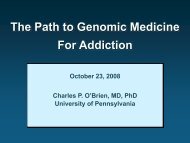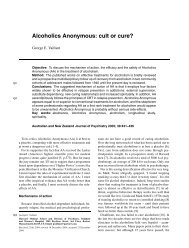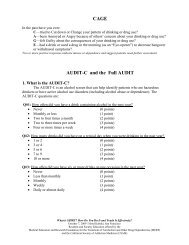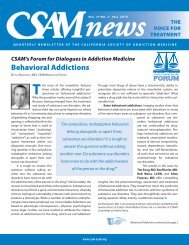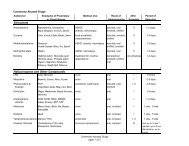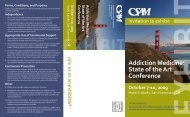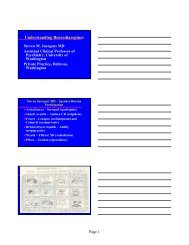SAN FRANCISCOMEDICINE - California Society of Addiction ...
SAN FRANCISCOMEDICINE - California Society of Addiction ...
SAN FRANCISCOMEDICINE - California Society of Addiction ...
Create successful ePaper yourself
Turn your PDF publications into a flip-book with our unique Google optimized e-Paper software.
To summarize up to this point: Every<br />
cell in our body contains the DNA to produce<br />
cannabinoid molecules and complex<br />
protein receptors. The CNS produces large<br />
quantities <strong>of</strong> both, relative to other neurochemicals,<br />
to create a pervasive modulatory<br />
system that enhances the brain’s flexibility<br />
and adaptability to a changing environment.<br />
Maintaining the endocannabinoid<br />
system in good tonic balance is presumably<br />
a good strategy for staving <strong>of</strong>f mortality.<br />
This brings us to the topic <strong>of</strong> addiction.<br />
Is there evidence for marijuana (i.e., THC)<br />
addiction And, if so, what is the clinical<br />
significance <strong>of</strong> marijuana addiction<br />
There are four lines <strong>of</strong> evidence <strong>of</strong><br />
physical addiction and withdrawal caused<br />
by THC. First, administering THC for seven<br />
days, followed by SR141716A (a cannabinoid<br />
antagonist that leads to sudden<br />
displacement <strong>of</strong> THC from cannabinoid<br />
receptors), produces similar symptoms<br />
across several species—snout rubbing,<br />
difficulty sleeping with characteristic EEG<br />
disturbances, “wet-dog shakes,” and so on.<br />
Second, clinical reports by humans seeking<br />
treatment for marijuana dependence<br />
include similar symptoms <strong>of</strong> irritability,<br />
anxiety, insomnia with characteristic EEG<br />
disturbances, restlessness, etc. Third,<br />
epidemiologic studies reveal that approximately<br />
9% <strong>of</strong> people who begin smoking<br />
marijuana at twenty-one years old or older<br />
eventually satisfy the criteria for cannabis<br />
dependence.<br />
The fourth line <strong>of</strong> evidence is the sine<br />
qua non for any addictive substance: THC<br />
causes a rise in dopamine levels in the<br />
nucleus accumbens (<strong>of</strong>ten called the reward<br />
center). While this is <strong>of</strong>ten equated to<br />
producing pleasure, complicated research<br />
on the distinction between “liking” and<br />
“wanting” is forcing addiction medicine<br />
to generate a more sophisticated picture<br />
<strong>of</strong> the neural mechanisms involved in the<br />
development <strong>of</strong> dependence.<br />
Liking is related to opioid, cannabinoid,<br />
and GABA manipulation in parts <strong>of</strong><br />
the palladium, and in only a small portion<br />
<strong>of</strong> the nucleus accumbens. There are plenty<br />
<strong>of</strong> experiences stimulated by THC that<br />
people like: relaxation, a sense <strong>of</strong> novelty<br />
(especially as concerns sensory stimuli),<br />
an altered attentional focus, reduced pain,<br />
timelessness, and so on. While marijuana<br />
stimulates these experiences, it also can<br />
leave the brain altered when used too<br />
consistently, because it can so excessively<br />
stimulate cannabinoid receptors that they<br />
begin to down-regulate, by as much as 60%<br />
in some areas <strong>of</strong> the brain. As a result, any<br />
cessation <strong>of</strong> exogenous stimulation (stopping<br />
smoking marijuana, for instance)<br />
leads to a relative cannabinoid deficiency<br />
state, generally considered to be unpleasant.<br />
Wanting, on the other hand, is a<br />
motivational force rather than a hedonic<br />
experience. Wanting is related to dopamine<br />
manipulation in the ventral tegmental area<br />
(VTA) and large parts <strong>of</strong> the nucleus accumbens.<br />
While the mechanisms underlying<br />
liking develop tolerance (through receptor<br />
down-regulation), the mechanisms<br />
underlying wanting become sensitized by<br />
continuous or large uses <strong>of</strong> a drug <strong>of</strong> addiction.<br />
Over time it takes less exposure to<br />
the drug, and fewer cues from the environment,<br />
to stimulate wanting and the deep<br />
motivation to obtain and use a drug, even<br />
when the pleasure value <strong>of</strong> the drug may<br />
have waned considerably.<br />
There is no doubt that many <strong>California</strong>ns<br />
like marijuana. The more penetrating<br />
question lies in why so many want it with<br />
such passion. Is this simply a matter <strong>of</strong><br />
libertarian fervor In some cases, yes. But<br />
why would such fervor be attached to the<br />
issue <strong>of</strong> access to marijuana Many would<br />
argue that devotion to the issue stems<br />
from the need to protect vital supplies <strong>of</strong><br />
a medicine that has become essential to<br />
their well-being. Perhaps. But addiction<br />
medicine practioners confront such fervent<br />
attachment to a variety <strong>of</strong> psychoactive<br />
drugs on a daily basis.<br />
While no one writhes in uncontrollable<br />
agony from marijuana withdrawal,<br />
as some opiate addicts do in the absence <strong>of</strong><br />
their drug, researchers do find a significant<br />
connection between pot’s subtle symptoms<br />
<strong>of</strong> abstinence and relapse behavior. Many<br />
people “prove” that they are not dependent<br />
on marijuana by abstaining for weeks, then<br />
find themselves “wanting” to smoke it again<br />
to calm the irritability they attribute to life’s<br />
stresses rather than to ongoing withdrawal.<br />
Discerning when patients are truly<br />
treating an underlying medical condition<br />
with “medical” marijuana from when they<br />
have smoked heavily enough to downregulate<br />
cannabinoid receptors (thus<br />
requiring exogenous cannabinoid stimulation<br />
in order to feel “normal”) is complex.<br />
It is also imprecise. This discernment can<br />
be accomplished only within the context <strong>of</strong><br />
a good therapeutic alliance with a patient<br />
who is willing to explore the conundrum<br />
honestly.<br />
Patients need to be viewed in a<br />
similar manner whether they are using<br />
marijuana or Vicodin. While either might<br />
be a useful medication, getting high every<br />
day through excessive use is still getting<br />
high every day. And relying solely on a<br />
patient’s judgment <strong>of</strong> what is the best<br />
medication for a given symptom is to<br />
abandon the scientific principles at the<br />
core <strong>of</strong> our medical training.<br />
Timmen Cermak, MD, is president <strong>of</strong> the<br />
<strong>California</strong> <strong>Society</strong> <strong>of</strong> <strong>Addiction</strong> Medicine. He<br />
is currently in private practice in psychiatry<br />
in Mill Valley.<br />
A full list <strong>of</strong> references is available online<br />
at www.sfms.org.<br />
Health Care Reform Law<br />
Gives Big Boost to <strong>Addiction</strong><br />
Treatment and Prevention<br />
Bob Curley, www.jointogether.org<br />
Don’t count addiction recovery advocates<br />
among those who see health care<br />
reform as the next Armageddon: The bill<br />
signed into law by President Obama includes<br />
addiction and mental health services<br />
in its basic benefits package and is being<br />
broadly praised by treatment, prevention,<br />
and recovery leaders. The new law requires<br />
that addiction and mental health benefits<br />
be provided in the same way as all other<br />
covered medical and surgical benefits.<br />
“Including addiction treatment in the<br />
basic benefit for all medical insurance is<br />
a major public health achievement,” said<br />
David Rosenbloom, PhD, <strong>of</strong> Join Together at<br />
Boston University School <strong>of</strong> Public Health.<br />
“Now we must turn our attention and advocacy<br />
to ensure that the promise is actually<br />
delivered in every community.”<br />
www.sfms.org June 2010 San Francisco Medicine 23




